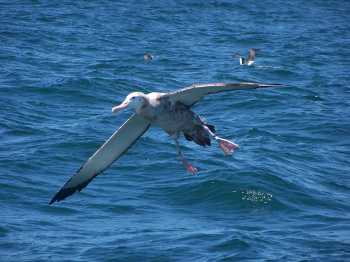Timothy Reid (FitzPatrick Institute, University of Cape Town, South Africa) and colleagues have published in the journal Endangered Species Research on the non-breeding movements of Critically Endangered Tristan Albatrosses Diomedea dabbenena from Gough Island.
The paper’s abstract follows:
“The Tristan albatross Diomedea dabbenena is Critically Endangered: >99% of adults breed at Gough Island, central South Atlantic Ocean, where chicks are threatened by introduced predators. At sea they mostly remain within the South Atlantic Ocean, where they are threatened by incidental capture in longline fisheries. Conservation measures to reduce seabird mortality in pelagic longline fisheries are confined largely to fishing effort south of 25°S. This covers the core range of breeding Tristan albatrosses, but the distribution of non-breeding adults and immature birds is unknown. We tracked 14 non-breeding adult Tristan albatrosses from Gough Island for up to 3 yr, from 2004 to 2006, using geolocating loggers. All birds remained in the South Atlantic or southern Indian Oceans, and showed distributions centred on the Sub-Tropical Convergence. They used the SW Atlantic during the austral summer and the SE Atlantic and Indian Oceans as far east as Australia during the austral winter. Foraging effort was concentrated in areas of upwelling and increased productivity. The distribution of the tracked birds overlapped with a range of pelagic longline fisheries, especially off southern Africa. Of particular concern was that 2 birds spent several months off the coast of Namibia and in adjacent high seas north of 25°S, where there are currently no regulations to prevent seabird bycatch during pelagic longline fishing operations.”

At risk: a Tristan Albatross at sea behind a fishing vessel in the South Atlantic
Photograph by Martin Abreu
The paper concludes: “[o]ur results suggest that current ICCAT [International Commission for the Conservation of Atlantic Tunas] seabird conservation measures should be extended north from 25 to 15°S in the area from 0°E to the Namibian coast”.
Reference:
Reid, T.A., Wanless, R.M., Hilton, G.M., Phillips, R.A. & Ryan, P.G. 2013. Foraging range and habitat associations of non‑breeding Tristan albatrosses: overlap with fisheries and implications for conservation. Endangered Species Research 22:39-49.
John Cooper, ACAP Information Officer, 23 November 2013

 English
English  Français
Français  Español
Español